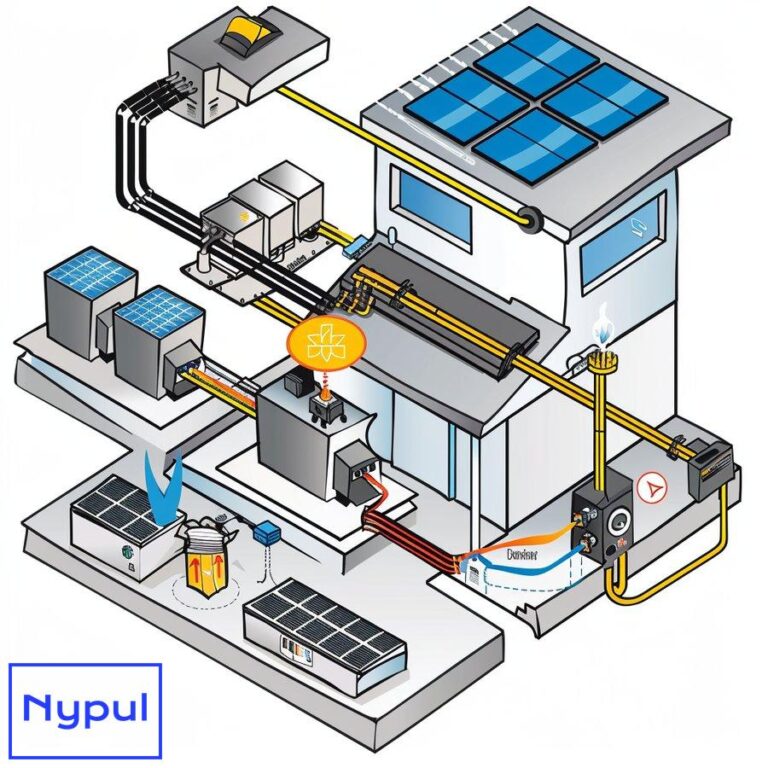What Is One of the Limitations of Automated Guided Vehicles AGVs Mentioned in the Content
What are Automated Guided Vehicles (AGVs) and how do they function in logistics?
Automated Guided Vehicles (AGVs) represent a significant advancement in material handling and logistics automation. These self-propelled vehicles navigate through predefined paths in warehouses, manufacturing facilities, and distribution centers, transporting materials, products, and equipment without direct human intervention.

AGVs utilize various guidance systems to navigate their environments:
Magnetic Tape Guidance: AGVs follow magnetic strips embedded in or applied to the floor. This system offers simplicity but lacks flexibility for route changes.
Laser Navigation: Vehicles equipped with laser scanners detect reflectors placed strategically around the facility. This method provides greater flexibility and accuracy.
Vision-Based Navigation: Cameras and computer vision algorithms allow AGVs to recognize and navigate based on environmental features.
Natural Navigation: Advanced AGVs use SLAM (Simultaneous Localization and Mapping) technology to create and update maps of their surroundings in real-time.
The core components of an AGV system include:
Vehicle: The physical platform that carries the load.
Navigation System: Determines the AGV’s position and guides it along the intended path.
Control System: Manages traffic, assigns tasks, and coordinates multiple AGVs.
Safety Systems: Sensors and mechanisms to prevent collisions and ensure safe operation.
Power System: Usually rechargeable batteries that provide energy for extended operation.
In logistics operations, AGVs perform various tasks:
Material Transport: Moving raw materials, work-in-progress items, and finished goods between storage areas and production lines.
Order Fulfillment: Retrieving products from storage locations for order picking and packing.
Pallet Handling: Transporting palletized loads to and from storage racks, trucks, or production areas.
Trailer Loading/Unloading: Automating the process of loading goods onto trailers or containers for shipping.
The integration of AGVs into logistics operations offers several benefits:
-
Increased Efficiency: AGVs operate continuously without breaks, maximizing productivity.
-
Enhanced Safety: Reducing human involvement in material handling minimizes accidents and injuries.
-
Improved Accuracy: AGVs follow precise paths and instructions, reducing errors in material placement and retrieval.
-
Cost Reduction: While initial investment is significant, AGVs can reduce long-term labor costs and improve operational efficiency.
-
Data Collection: AGVs can be equipped with sensors to collect valuable data on inventory movements and operational patterns.
To illustrate the impact of AGVs on logistics operations, consider the following comparison:
| Metric | Traditional Manual Operation | AGV-Enabled Operation |
|---|---|---|
| Operating Hours | 8-12 hours/day | 24 hours/day |
| Error Rate | 1-3% | <0.1% |
| Labor Costs | High | Reduced by 40-60% |
| Throughput | Variable | Consistent |
| Safety Incidents | 2-5 per year | <1 per year |
While AGVs offer significant advantages, they also present challenges, particularly in terms of flexibility. Understanding these limitations is crucial for businesses considering AGV implementation in their logistics operations.
Why is flexibility a significant limitation for AGVs?

Flexibility, or rather the lack thereof, stands as a significant limitation for Automated Guided Vehicles (AGVs) in logistics and manufacturing environments. This constraint stems from the fundamental design and operational principles of AGVs, which prioritize efficiency and reliability in predefined scenarios over adaptability to changing conditions.
The rigidity of AGV systems manifests in several key areas:
Fixed Routing: Traditional AGVs follow predetermined paths, often guided by magnetic strips or wires embedded in the floor. While efficient for repetitive tasks, this system struggles to accommodate layout changes or temporary obstructions.
Limited Task Variability: AGVs excel at performing repetitive, standardized tasks. However, they lack the versatility to handle unexpected situations or perform varied tasks without reprogramming.
Inflexible Load Handling: Many AGVs are designed to handle specific load types and sizes. Adapting to different load characteristics often requires physical modifications or even replacement of the AGV.
Constrained Navigation: AGVs typically rely on a fixed infrastructure for navigation, such as floor markers or beacons. This dependency limits their ability to operate in dynamic or unstructured environments.
Programmed Decision-Making: Unlike human operators who can make real-time decisions based on complex situational factors, AGVs follow pre-programmed logic, which may not account for all possible scenarios.
The impact of these flexibility limitations becomes particularly evident when comparing AGVs to human workers:
| Aspect | Human Worker | AGV |
|---|---|---|
| Route Adaptation | Can easily change routes | Requires reprogramming or infrastructure changes |
| Task Variety | Capable of performing diverse tasks | Limited to specific, programmed tasks |
| Problem Solving | Can address unexpected issues creatively | Follows fixed protocols, may stop when encountering unforeseen obstacles |
| Load Handling | Adaptable to various load types and sizes | Often specialized for specific load characteristics |
| Environmental Awareness | Can navigate complex, changing environments | Struggles with significant environmental changes |
The rigidity of AGVs can lead to several operational challenges:
-
Reduced Operational Agility: The inability to quickly adapt to changing production or logistics needs can hinder overall operational flexibility.
-
Increased Downtime: When faced with unexpected obstacles or situations, AGVs may stop and require human intervention, leading to productivity losses.
-
Limited Scalability: Expanding or modifying AGV systems often requires significant time and investment, making it difficult to scale operations rapidly.
-
Constrained Layout Design: Facility layouts must be designed around AGV paths and capabilities, potentially limiting optimal space utilization.
-
Integration Challenges: The inflexibility of AGVs can complicate their integration with other automated systems or human-operated processes.
Understanding these flexibility limitations is crucial for businesses considering AGV implementation. While AGVs offer significant benefits in terms of efficiency and consistency, their rigidity can pose challenges in dynamic or rapidly evolving operational environments. Addressing these limitations requires careful planning, potentially hybrid solutions combining AGVs with more flexible automation technologies, and ongoing evaluation of operational needs against AGV capabilities.
How does the limited flexibility of AGVs impact operational agility?
The limited flexibility of Automated Guided Vehicles (AGVs) significantly impacts operational agility in logistics and manufacturing environments. Operational agility refers to an organization’s ability to quickly adapt to changing market conditions, customer demands, and internal process requirements. The rigidity inherent in AGV systems can create bottlenecks and challenges that hinder this crucial aspect of modern business operations.

Key areas where AGV inflexibility affects operational agility include:
Production Line Changes: In manufacturing environments, product variations or new product introductions often require changes to production line layouts or material flow. AGVs with fixed routes struggle to accommodate these changes without significant reprogramming or infrastructure modifications.
Inventory Management: Agile inventory management requires the ability to quickly relocate stock or adjust storage configurations. AGVs designed for specific storage layouts may impede rapid reorganization of warehouse spaces.
Order Fulfillment: E-commerce and omnichannel retail demand highly flexible order fulfillment processes. AGVs optimized for standard pallet movements may not efficiently handle the diverse picking and packing requirements of modern distribution centers.
Seasonal Variations: Many industries experience seasonal fluctuations in demand or product mix. AGV systems designed for peak capacity may be inefficient during low periods, while those optimized for average loads may struggle during high-demand seasons.
Emergency Response: In situations requiring rapid operational changes (e.g., equipment breakdowns, rush orders), the programmed nature of AGVs can limit an organization’s ability to quickly reallocate resources or alter workflows.
To illustrate the impact of AGV inflexibility on operational agility, consider the following scenarios:
| Scenario | Impact of AGV Inflexibility | Agile Alternative |
|---|---|---|
| Sudden increase in small-item orders | AGVs designed for pallet movement struggle to efficiently handle individual item picks | Flexible robotic picking systems or human pickers can quickly adapt to new order profiles |
| Introduction of new product line | Fixed AGV routes may not align with new production layout needs | Autonomous Mobile Robots (AMRs) can dynamically adjust paths to serve new production areas |
| Temporary obstruction in AGV path | AGV stops, requiring human intervention to clear path or reroute | Human operators or more advanced robots can navigate around obstacles |
| Rapid scaling of operations | Expanding AGV system requires significant time for infrastructure changes | Cloud-based fleet management systems allow for quicker scaling of more flexible automated solutions |
The consequences of these agility limitations include:
-
Delayed Response to Market Changes: The time required to modify AGV systems can slow an organization’s ability to capitalize on new market opportunities or respond to competitive pressures.
-
Increased Operational Costs: The need for human intervention to manage AGV limitations in dynamic environments can negate some of the cost savings typically associated with automation.
-
Reduced Customer Satisfaction: Inflexibility in order fulfillment processes can lead to longer lead times and decreased ability to meet custom or rush order requests.
-
Inefficient Resource Utilization: AGVs designed for specific tasks may sit idle during periods of low demand for those particular operations, leading to underutilization of expensive assets.
-
Innovation Constraints: The significant investment in AGV infrastructure may discourage organizations from adopting newer, more flexible technologies, potentially hindering long-term competitiveness.
To mitigate these impacts, organizations employing AGVs must:
Implement Hybrid Solutions: Combining AGVs with more flexible automation technologies or human workers can provide a balance between efficiency and agility.
Invest in Advanced AGV Technologies: Newer AGV models with improved navigation systems and AI capabilities offer greater flexibility than traditional systems.
Develop Agile Operational Strategies: Creating processes that anticipate and accommodate the limitations of AGV systems can help maintain overall operational agility.
Regularly Reassess Automation Needs: Continuously evaluating the balance between AGV efficiency and operational flexibility ensures that automation solutions evolve with business requirements.
While AGVs offer significant benefits in terms of efficiency and consistency, their impact on operational agility must be carefully considered. Organizations must weigh the trade-offs between the predictability and efficiency of AGVs against the need for flexibility in an ever-changing business landscape. Successful integration of AGVs into agile operations requires a strategic approach that anticipates and addresses these flexibility challenges.
What causes the flexibility constraints in AGV operations?
The flexibility constraints in Automated Guided Vehicle (AGV) operations stem from a combination of technological limitations, design choices, and operational requirements. Understanding these root causes is crucial for developing strategies to mitigate their impact and improve overall system flexibility.
Key factors contributing to AGV flexibility constraints include:
Navigation System Design:
Traditional AGV navigation systems rely on fixed infrastructure such as magnetic strips, wires, or reflectors. This dependency limits the AGV’s ability to adapt to changes in the operational environment.
Magnetic Guidance: AGVs following magnetic strips embedded in the floor are confined to predetermined paths. Any change in route requires physical modification of the floor infrastructure.
Laser Navigation: While more flexible than magnetic guidance, laser-guided AGVs still depend on fixed reflectors in the environment. Significant changes to the operational layout may require repositioning of these reflectors.
Programming Complexity:
AGVs operate based on pre-programmed instructions and decision trees. Modifying these programs to accommodate new tasks or routes often requires specialized skills and can be time-consuming.
Task-Specific Design:
Many AGVs are engineered for specific applications, optimizing their performance for particular tasks at the expense of versatility.
Load Handling Mechanisms: AGVs designed for pallet transport may struggle with different load types or sizes.
Specialized End Effectors: AGVs equipped with task-specific tools (e.g., robotic arms for picking) may not be easily adaptable to other tasks.
Safety Protocols:
Stringent safety requirements often result in conservative operational parameters that limit an AGV’s ability to navigate dynamic environments.
Obstacle Avoidance: Many AGVs are programmed to stop when encountering unexpected obstacles, requiring human intervention to resume operation.
Speed Limitations: Safety considerations often restrict AGV speeds, particularly in areas with human traffic, impacting their ability to respond quickly to changing operational needs.
Battery Life and Charging Requirements:
The need for regular battery charging constrains the operational flexibility of AGVs, particularly in 24/7 operations.
Charging Station Locations: Fixed charging station positions can limit route flexibility and operational layouts.
Battery Swap Procedures: Some AGV systems require manual battery swaps, introducing human-dependent bottlenecks in the automation process.
Integration with Existing Systems:
AGVs must often interface with other automated systems (e.g., conveyor belts, automated storage and retrieval systems) which can introduce additional constraints on their flexibility.
Communication Protocols: Limitations in wireless communication or network coverage can restrict an AGV’s operational range or responsiveness.
Data Exchange Requirements: The need to synchronize with warehouse management systems or production control systems can introduce latency in adapting to changes.
Regulatory and Compliance Factors:
Industry-specific regulations or compliance requirements may impose additional constraints on AGV operations, limiting their adaptability.
Standardization Requirements: In some industries, the need for standardized processes can limit the implementation of more flexible AGV solutions.
Documentation and Validation Processes: Changes to AGV operations in regulated environments may require extensive documentation and validation, slowing the pace of adaptation.
To illustrate the impact of these factors on AGV flexibility, consider the following comparison:
| Flexibility Factor | Traditional AGV | Human Operator | Advanced AMR (Autonomous Mobile Robot) |
|---|---|---|---|
| Route Adaptation | Requires physical infrastructure changes | Can instantly adapt to new routes | Can dynamically plan new routes using SLAM technology |
| Task Variability | Limited to programmed tasks | High adaptability to various tasks | Moderate adaptability with AI and modular design |
| Obstacle Avoidance | Often stops and requires intervention | Can navigate around obstacles creatively | Can autonomously navigate around most obstacles |
| Load Handling | Specific to design | Highly adaptable | Moderately adaptable with interchangeable attachments |
| Operating Hours | Limited by battery life and charging needs | Shift-based with fatigue factors | Extended operation with opportunity charging or hot-swappable batteries |
| System Integration | Often requires significant IT resources | Can adapt to system changes with training | Can often integrate more easily with modern IT systems |
Understanding these constraints is essential for organizations considering AGV implementation or looking to improve the flexibility of existing AGV operations. Addressing these limitations may involve:
-
Investing in Advanced Navigation Technologies: Adopting SLAM-based navigation systems can significantly enhance AGV flexibility.
-
Implementing Modular AGV Designs: Choosing AGVs with interchangeable components or attachments can improve adaptability to different tasks.
-
Developing More Sophisticated Control Software: Investing in AI-enhanced control systems can improve AGV decision-making capabilities in dynamic environments.
-
Creating Hybrid Operational Models: Combining AGVs with human operators or more flexible automation technologies can provide a balance of efficiency and adaptability.
-
Regular Assessment and Upgrade Planning: Continuously evaluating AGV performance against operational needs and planning for regular technology upgrades can help maintain system flexibility over time.
By addressing these root causes of flexibility constraints, organizations can work towards creating more adaptable AGV systems that better align with the dynamic needs of modern logistics and manufacturing environments.
How do AGVs compare to human workers in terms of adaptability?
When comparing Automated Guided Vehicles (AGVs) to human workers in terms of adaptability, it’s essential to recognize the distinct strengths and limitations of each. This comparison highlights the trade-offs between the consistency and efficiency of AGVs and the versatility and problem-solving capabilities of human workers.

Key areas of comparison include:
Task Variety:
Human Workers: Humans excel at performing a wide range of tasks and can quickly switch between different types of work. They can easily adapt to new processes or job requirements with minimal training.
AGVs: Traditional AGVs are designed for specific, repetitive tasks. Adapting an AGV to a new task often requires reprogramming or even physical modifications to the vehicle.
Problem-Solving:
Human Workers: Humans possess superior cognitive abilities, allowing them to creatively solve unexpected problems, make judgment calls, and adapt to unforeseen circumstances.
AGVs: AGVs follow pre-programmed logic and struggle with situations outside their programmed parameters. When encountering unexpected obstacles or scenarios, AGVs typically stop and require human intervention.
Environmental Awareness:
Human Workers: Humans have advanced sensory capabilities and can quickly assess and adapt to changes in their environment, including recognizing potential hazards or inefficiencies.
AGVs: While equipped with sensors, AGVs have limited environmental awareness. They can detect obstacles but may not understand the context or nature of the obstruction.
Learning and Improvement:
Human Workers: Humans can learn from experience, continuously improving their performance and adapting their methods based on changing conditions.





